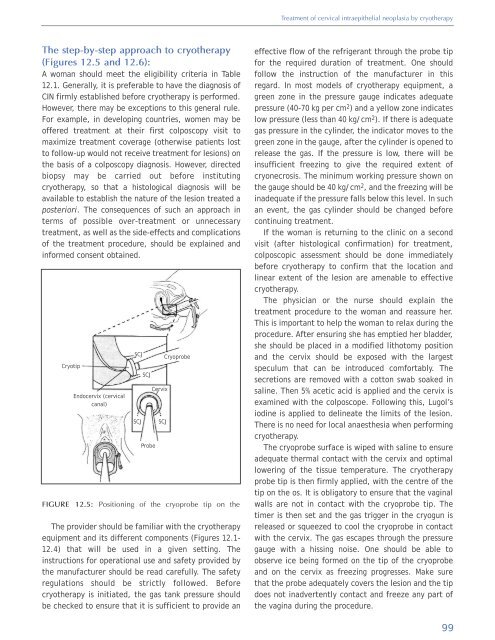Colposcopy and Treatment of Cervical Intraepithelial Neoplasia - RHO
Colposcopy and Treatment of Cervical Intraepithelial Neoplasia - RHO
Colposcopy and Treatment of Cervical Intraepithelial Neoplasia - RHO
You also want an ePaper? Increase the reach of your titles
YUMPU automatically turns print PDFs into web optimized ePapers that Google loves.
<strong>Treatment</strong> <strong>of</strong> cervical intraepithelial neoplasia by cryotherapy<br />
The step-by-step approach to cryotherapy<br />
(Figures 12.5 <strong>and</strong> 12.6):<br />
A woman should meet the eligibility criteria in Table<br />
12.1. Generally, it is preferable to have the diagnosis <strong>of</strong><br />
CIN firmly established before cryotherapy is performed.<br />
However, there may be exceptions to this general rule.<br />
For example, in developing countries, women may be<br />
<strong>of</strong>fered treatment at their first colposcopy visit to<br />
maximize treatment coverage (otherwise patients lost<br />
to follow-up would not receive treatment for lesions) on<br />
the basis <strong>of</strong> a colposcopy diagnosis. However, directed<br />
biopsy may be carried out before instituting<br />
cryotherapy, so that a histological diagnosis will be<br />
available to establish the nature <strong>of</strong> the lesion treated a<br />
posteriori. The consequences <strong>of</strong> such an approach in<br />
terms <strong>of</strong> possible over-treatment or unnecessary<br />
treatment, as well as the side-effects <strong>and</strong> complications<br />
<strong>of</strong> the treatment procedure, should be explained <strong>and</strong><br />
informed consent obtained.<br />
Cryotip<br />
Endocervix (cervical<br />
canal)<br />
SCJ<br />
SCJ<br />
Cryoprobe<br />
FIGURE 12.5: Positioning <strong>of</strong> the cryoprobe tip on the<br />
The provider should be familiar with the cryotherapy<br />
equipment <strong>and</strong> its different components (Figures 12.1-<br />
12.4) that will be used in a given setting. The<br />
instructions for operational use <strong>and</strong> safety provided by<br />
the manufacturer should be read carefully. The safety<br />
regulations should be strictly followed. Before<br />
cryotherapy is initiated, the gas tank pressure should<br />
be checked to ensure that it is sufficient to provide an<br />
SCJ<br />
Probe<br />
Cervix<br />
SCJ<br />
effective flow <strong>of</strong> the refrigerant through the probe tip<br />
for the required duration <strong>of</strong> treatment. One should<br />
follow the instruction <strong>of</strong> the manufacturer in this<br />
regard. In most models <strong>of</strong> cryotherapy equipment, a<br />
green zone in the pressure gauge indicates adequate<br />
pressure (40-70 kg per cm 2 ) <strong>and</strong> a yellow zone indicates<br />
low pressure (less than 40 kg/cm 2 ). If there is adequate<br />
gas pressure in the cylinder, the indicator moves to the<br />
green zone in the gauge, after the cylinder is opened to<br />
release the gas. If the pressure is low, there will be<br />
insufficient freezing to give the required extent <strong>of</strong><br />
cryonecrosis. The minimum working pressure shown on<br />
the gauge should be 40 kg/cm 2 , <strong>and</strong> the freezing will be<br />
inadequate if the pressure falls below this level. In such<br />
an event, the gas cylinder should be changed before<br />
continuing treatment.<br />
If the woman is returning to the clinic on a second<br />
visit (after histological confirmation) for treatment,<br />
colposcopic assessment should be done immediately<br />
before cryotherapy to confirm that the location <strong>and</strong><br />
linear extent <strong>of</strong> the lesion are amenable to effective<br />
cryotherapy.<br />
The physician or the nurse should explain the<br />
treatment procedure to the woman <strong>and</strong> reassure her.<br />
This is important to help the woman to relax during the<br />
procedure. After ensuring she has emptied her bladder,<br />
she should be placed in a modified lithotomy position<br />
<strong>and</strong> the cervix should be exposed with the largest<br />
speculum that can be introduced comfortably. The<br />
secretions are removed with a cotton swab soaked in<br />
saline. Then 5% acetic acid is applied <strong>and</strong> the cervix is<br />
examined with the colposcope. Following this, Lugol’s<br />
iodine is applied to delineate the limits <strong>of</strong> the lesion.<br />
There is no need for local anaesthesia when performing<br />
cryotherapy.<br />
The cryoprobe surface is wiped with saline to ensure<br />
adequate thermal contact with the cervix <strong>and</strong> optimal<br />
lowering <strong>of</strong> the tissue temperature. The cryotherapy<br />
probe tip is then firmly applied, with the centre <strong>of</strong> the<br />
tip on the os. It is obligatory to ensure that the vaginal<br />
walls are not in contact with the cryoprobe tip. The<br />
timer is then set <strong>and</strong> the gas trigger in the cryogun is<br />
released or squeezed to cool the cryoprobe in contact<br />
with the cervix. The gas escapes through the pressure<br />
gauge with a hissing noise. One should be able to<br />
observe ice being formed on the tip <strong>of</strong> the cryoprobe<br />
<strong>and</strong> on the cervix as freezing progresses. Make sure<br />
that the probe adequately covers the lesion <strong>and</strong> the tip<br />
does not inadvertently contact <strong>and</strong> freeze any part <strong>of</strong><br />
the vagina during the procedure.<br />
99
















